HMS Venturer, the first of the Royal Navy’s new Type 31 frigates, has taken another step forward with the installation of her foremast at Babcock’s Rosyth facility.
With the 24 metric tonne foremast now in place, weighing the same as 10 full-size Range Rovers, the profile of HMS Venturer is nearing completion, offering a visible sign of momentum as outfitting continues ahead of sea trials next year.
The successful lift and integration required close coordination between several specialist engineering and lifting teams. The foremast travelled from the Venturer Building to the dockside at Rosyth before being raised and placed on the ship.
Paul Watson, Babcock’s Arrowhead Managing Director, said: “HMS Venturer will play an important part in the Royal Navy’s defence capabilities. The foremast installation on the vessel marks another important milestone and clearly demonstrates the progress being made across the Type 31 programme.”
The Type 31 programme, also known as the Inspiration class, is central to the Royal Navy’s future surface fleet, designed to provide a versatile and affordable frigate capable of global deployments. HMS Venturer is expected to begin sea trials in 2026
The Type 31 frigate was gently lowered into the River Forth at the Port of Leith recently.
As of August 2025, three of the Royal Navy’s 13 new frigates under construction in Scotland have entered the water: HMS Venturer (Type 31), HMS Glasgow, and HMS Cardiff (both Type 26). In total, eight have reached the steel-cut stage—five Type 26 vessels (Glasgow, Cardiff, Belfast, Birmingham, Sheffield) and three Type 31 ships (Venturer, Active, Formidable).




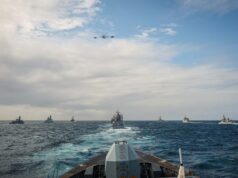

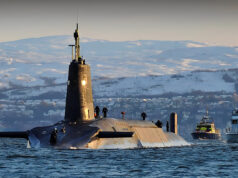
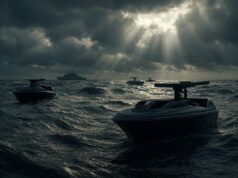



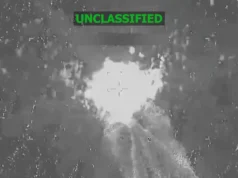
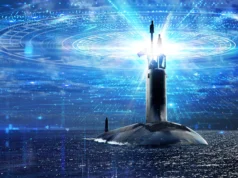

I wonder how much new technology will influence future shipbuilding, especially naval vessels. Robotics must have a significant role going forward and allow much faster build rates. AI in combination with robotics is an inevitable marriage, but just how much can these systems really achieve? Another interesting development is being adopted by Tesla and now Ford where they hope to achieve around 40% reduction in sub-assemblies. One long-term result of using modern remote systems is the possibility of reducing ship production complexity and time to where vessels can be ordered depending on need, thus allowing for an improved amortisation of budgets. Imagine a Type 31 being built in just 12 months!
The big concern, what will all those workers replaced by ai, robots or just more effecient sub assemblies do for work?
Add in the impact on local shops and the suppliers of goods.
We are in for interesting times ahead as workers in multiple areas are all subject to attack from development. That’s in addition to the affects of cheaper labour overseas.
Im beginning to understand how the luddites felt!
The social aspects are not the MOD’s chief concern, though I’m sure their HR department would use more acceptable language. The use of super-efficient technology is as inevitable as Christmas and the potential cost/time savings on military equipment may be too tempting to ignore. Equally, our potential foe will not hesitate to use whatever means to match and even surpass our own abilities. The notion that a principal naval vessel could be ordered and in service in under two years may seem like fairyland, but new technology is rapidly changing established mindsets.
All true and valid points.
But when vast swathes of the population are living on universal basic income supplied by the state, where will the money come from to fund the ships.
When AI and Tech gets to the level of Building Warships independently we won’t need Ships – things will have moved on.
As I mentioned previously, the moral implications of displacing human beings from the assembly process will not be the primary driver in deciding to use advanced technology in military programs, due to the nature of the business. Obviously, there will be huge ramifications for all modern societies, but the gravity of progress will ultimately determine the outcomes. The British Industrial Revolution saw vast swaths of people move from the land to the cities, and though the conditions were poor (to our modern standards) many ended up in brand new homes supplied by the factory owners. The outcomes from the implementation of AI and robotics will result in winners and losers in equal measure, but that has always been the case as man moves forward.
Excellent point and very well made. The UK has seen this all before of course, but it still begs the question what happens to the workforce?
In the 80’s tens of thousands of Mine workers lost their livelihood. Parts of Wales, County Durham, Northumberland and North Derbyshire, have some of the poorest towns in the UK. In fact some former coal towns still struggle to this day, with high levels of unemployment.
The Car industry has shed tens of thousands of jobs since the 90’s. It’s a reasonable question to ask what happens to all those livelihoods however, progress has always been marred by job losses.
It took 2 years to build HMS Warrior 1859 to 1861. And this was the first ironclad, iron hulled warship ever built.
And 14 months for HMS dreadnought..the first turbine all big gun battleship.
6,000 man weeks of prep, material stockpiling, and compulsory overtime.
Also, the British coffers were full of money from the colonies.
Are you a Russian bot?
Are you an Icecream seller ?
An interesting and somewhat scary question. Jobs in manufacturing robots will be created but then we might employ robots to build the robots and where to from there? In theory manufacturers should reduce prices per the saving in wages versus the cost of using robots and pass on the benefit to humans in reduced prices. Thus humans don’t need as much money to live and can survive well on state grants.
Or something like that….
Maybe they can work maintaining the current ships, given the backlog. It’s not like there’s no work to be done for the foreseeable future. There’s a generation’s worth, and it’s pointless worrying past that. With BAE and Babcock accelerating their apprentice programmes and Navantia regenerating in Belfast and Devon, and even Methil is building barges, it seems an odd time to worry about layoffs.
Reading about the South Korean shipyards the impression gained is that they design the blocks for factory build and to fitted out to max possible state before assembly in yard to save time in fitting out which gives them one the world’s fastest shipyard build completion times, understand Glasgow still in Scotstoun being fitted out since moved way back in Nov. ’22.
The QE Class carriers used modular units built away from the yard and delivered at given points of assembly. These were the principles used for crew quarters and other environments, and no doubt valuable lessons were learnt.
Robots are used extensively primarily in the cutting but there is limited ability to use then more as in the car industry due to very small batch sizes.
I should think that many of the fabrication and machining processes are already done by CNC (computer numerical control) machines.
Current AI may not offer much improvement there.
It appears the fitting out processes still require humans, but possibly the testing or test planning could be helped by AI
I guess the current processes use growing levels of automation; however, it’s probably only scratching the surface in terms of what advanced technology will deliver.
Automating the outside hull construction would mean an investment in very large robots (if such things exist)
Automating fitting would mean using machines that can access anywhere inside the ship, as well as having the ability to do external work.
I think shipbuilders jobs are safe from AI for a couple of decades, unlike those of us who earn a living staring at computer screens.
** fitting out **
I’m sure what we believe to be obstacles aren’t there in the scheme of things, for example, heavy-duty drones could address the movement and assembly of large sections, and smaller drones and robots operate on the interior construction and fitting out. Obviously, humans will still be involved, but imagine telling a car assembly worker in 1950 that car body shells would be assembled completely by robots without any physical human contact.
Quotes on AI from Pope Leo.
“No generation has ever had such quick access to the amount of information now available through AI,” he said. But “access to data — however extensive — must not be confused with intelligence.” Did the rot set in with Google?
He also expressed concern about AI’s impact on children’s “intellectual and neurological development,” writing that “society’s well-being depends upon their being given the ability to develop their God-given gifts and capabilities.”Bring back log tables and slide rules. That will learn ‘em. 😂
I have two kids with SEND. They have learnt to use Chat GPT to express themselves in written form; they have great imaginations but their struggle with writing previously prevented them from getting their ideas out. Now, they have learnt how to write prompts and change the output from the AI until it reads what they meant.
I never saw that coming!
That’s a nice story. AI makes their ideas a reality – sort of fills in the mental processing step. Reminds me of the German word ‘realisation’. Be interesting to see if in future they ‘take over ‘ the AI step with their human intelligence 🙂
*Quotes on AI by Pope Leo*
LOL.
AI is only the friend of the rich.
Wrong.
AI is the friend of the Chinese and they are way ahead.
We are soon to be stuffed.
All great news, can’t be long now until she gets ready for trials.👀
Now then, about these *Full Sized Range Rovers*, They are all *full size* and all called Range Rovers, just different ranges have different dimensions. 🤦♂️
Just have to hope it is better designed and built than a Range Rover.
Used to be a loyal Land Rover customer and had plenty of reliable vehicles from them.
Now, wouldn’t touch on a barge pole.
Do you get half sized range rovers?
Isn’t that just the Evoque?
We measure weights in Range Rovers and missile targets in tennis balls, any other silly measure we should be using?
Yes. *Glaciation*, It’s a good measure for most UK Defence Projects. 💣⌛💤
It has been established over many years that the approved yardstick for weight and length are London Buses, and that for area is Football Pitches.
Area: small is football pitches, large is Belgium.
Volume is measured in Olympic swimming pools.
Duration/range/Consumption is measured in tins of beans and Sausages.
I think this is the alternative SI unit….Silly Information Units….
Tins of beans can also be used to measure the Empire Sate Building and for filling in potholes. Make a scale model of the Empire state Building exactly the same height as a tin of beans. Ask the model maker what scale he used, andmultiply the ration times the height of the tin
multiply the ratio…..
Some things are measured in pinhead sizes? Any thoughts?
Yes, Pin Heads.
I was hoping for something better than that! Like MOD Planners’ brains. Or is that too obvious.
I’m just a Halfwit, I took the obvious route !
I don’t think that the Port of Leith was every in the frame as the launch site………
What do you mean? Look back and check reality. Venturer (as will all T31s) was towed to Leith on the barge from Rosyth and lowered into the water alongside the port there. Do catch up.
The Type 26’s had to be towed some distance for Float Off from the Barge, I thought the 31’s didn’t need to be moved far. 🤔?.
Now they just have to knock out 12 of them in total and the RN will be back on track for for two major surface combatant types, 20 ASW and GP frigates.. then it’s just working on getting 10 AAW ships and jobs a good one.
In the real world HMS Venture should be operational in 28/29 after first in class trials.. at which point it will be 20-25% of the RN frigate fleet.
Another way to look at it is that the T31s + River 2s +River 1s will be almost 50% of the total ‘warship’ ( T23/T26/T45 = 14) fleet. And much more than 50% if the measure is actually being present and days at sea. Putting aside debate about their armament, the batch 2 Rivers are really global sloops, and could easily be converted to such. HMS Spey’s transit of the Taiwan strait was the present day equivalent of HMS Amethyst’s sail up the Yangste.
I would have no issue with the rivers 2 being used as patrol frigates, if they got the self defence of a patrol frigates.. as is they are doing a patrol frigate job with the self defence of an EEZ constabulary vessel.
Good news and 2026 is finally coming around so the RN will so be able to commission a new frigate. First one in 30 years or so..? Or will Glasgow be first 🙂
Now order a second batch of T31 while the supply chains are still hot or at least lukewarm.
Hopefully we will hear that the Norwegians have ordered half a dozen T26 which will help to fund a few frigates.
Cheers CR
Second and third batch.. simply put they should just keep building variants of the T31 until the RN is back up to 30-32 major surface combatants.
Yes. I’d like us to keep building second tier frigates even after we’ve reached the number required for the Navy. If we take your numbers and assume 6+8 top tier escorts, then you would be looking at 16-18 T31s. If they can be built one a year, the oldest will be maybe 19 years old by the time the Navy receives the last one in 2046. They can sell it the following year in 2047 when the next one arrives. That way the Navy never has it’s second tier frigates go over twenty years old.
It’s time to sign the follow up order for a further 5 x T31+ frigates. More capable with sonar & vls41
Then as the 1st 5 rotate back for mid life docking upgrade them to + standard
This will of course require forward planning by MoD, politicians and HM Treasury so no real problems !